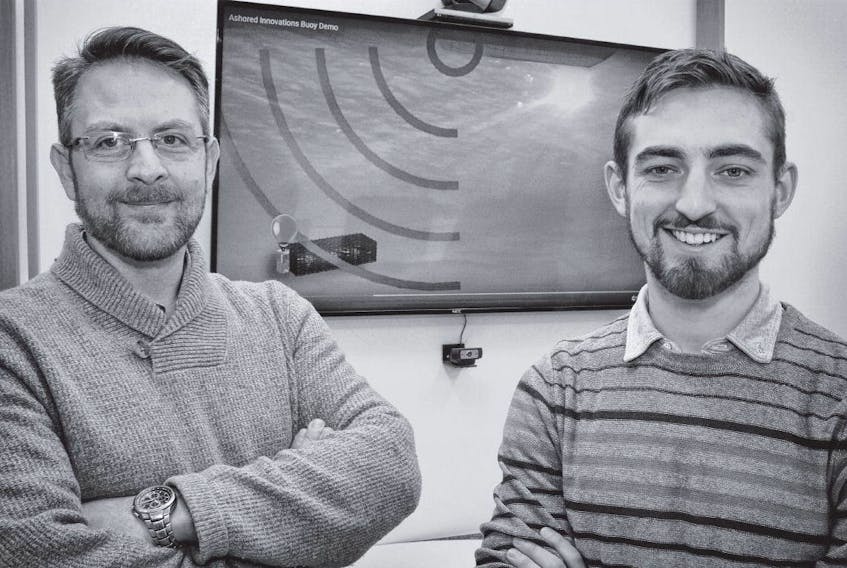A trio of graduate students at Saint Mary’s University is building a fishing gear prototype that could help lobster and crab fishermen save money by reducing lost traps and save whales and other marine life from becoming entangled in ropes.
Ross Arsenault and Aaron Stevenson are in the two-year masters of technology entrepreneurship and innovation program, while Maxwell Poole is taking a masters of applied health services research.
While Arsenault and Stevenson work out of an office at Saint Mary’s in south-end Halifax, Poole can mostly be found in his grandfather’s custom metalwork shop in Yarmouth.
Arsenault and Poole did undergraduate degrees in marketing at SMU and had been planning to work together on fishing gear improvements for their master’s degrees. One day, Arsenault overheard Stevenson talking about similar issues and knew he had to join the project.
“Initially the goal was to develop a smart trap, and that came just based on the thought of, well, OK, so much money is being invested into Nova Scotia, and it’s an economy that’s kind of struggling, but wants to reinvent itself as this East Coast tech startup hub,” said Arsenault.
“Well, what’s the best resource we have? What is actually going to create jobs and create a strong sector here, and that’s ocean tech.”
Arsenault and Stevenson said their initial plans were for gear that could tell fishermen when their traps held fish so they could save money by reducing the number of trips to sea and eliminate hauling empty or near-empty pots.
But in discussions with fishermen, they found their idea wouldn’t be all that helpful because empty traps need to be hauled anyway and moved to a more productive area.
Then, the students heard about the crisis facing the endangered North Atlantic right whale, which was dying in record numbers in Canadian waters last year.
The students knew they needed an idea that would work and would make business sense, but they are also concerned with social entrepreneurship that provides more than just a financial benefit, so they decided to focus on improvements that would help fishermen and the whales.
“As we move forward, we want to work in conjunction with the Department of Fisheries and Oceans and with the industry as well so we ensure that we’re (creating) a solution that’s going to solve a problem and that is going to be a good fit — one that the market wants and that has more than just a return on the investment,” said Stevenson.
“It can’t just be about saving the whales. There’s got to be a benefit for (fishermen).
“We didn’t want to just do something for the sake of technology, or do something for the sake of an app or whatever. We wanted to actually make a real difference in the lives of people.”
Fisheries experts say there are between 450 and 500 North Atlantic right whales left, and the numbers are shrinking.
At least 12 of 17 right whales found dead last year were in Canadian waters, mostly due to blunt trauma, likely from ship strikes, or fishing gear entanglement.
A further five right whales were discovered alive but entangled in the Gulf of St. Lawrence, according to the Department of Fisheries and Oceans.
Another right whale was found dead off the southern U.S. coast last month, likely due to entanglement, the National Oceanic and Atmospheric Administration said.
In Canada, the federal government has implemented speed restrictions on ships when right whales are present in the Gulf and has said it is considering changes to fishing regulations to reduce entanglements.
Lobster and crab traps are set on the sea bottom with buoy markers floating on the surface, attached by ropes.
Engineers at the Woods Hole Oceanographic Institution in Massachusetts are currently testing ropeless gear and the Department of Fisheries and Oceans is considering the idea as one way to help reduce the deaths of endangered right whales off Canada’s east coast.
So-called ghost traps that can no longer be hauled up have to be replaced and cost fishermen money, and they continue to trap crustaceans, leading to their death.
Some have suggested using lighter rope with break-away mechanisms to prevent entanglements, but fishermen say they need strong rope to haul heavy traps hundreds of metres up from the bottom and to keep from losing traps in heaving seas.
Ropeless fishing isn’t truly ropeless. Instead, the rope is spooled and stored on the ocean bottom with the traps. When fishermen want to haul the traps up, an electronic signal is sent from a boat releasing a buoy that carries rope to the surface.
Arsenault and Stevenson said their system will save fishermen money by reducing the number of traps lost and will also help protect marine life from entanglement.
They said Poole has already built a prototype and the trio has signed up fishermen to try it out under sea conditions this year.
They are also looking at lowcost alternatives to make it attractive for industry to retrofit existing traps.
“We’ve received tremendous support from people offering up different opportunities to use their facilities for piloting this and for testing it,” said Arsenault.
“The goal is to have something ready-for-market by next year.”









